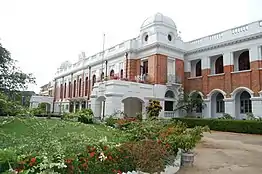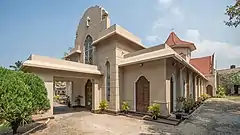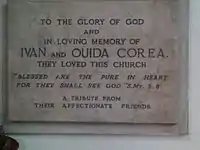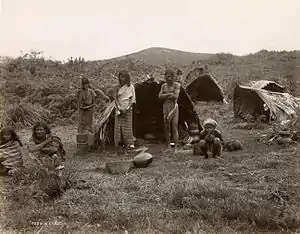Ivan Corea
Hector Vernon Ivan Seneviratne Corea (Sinhala: හෙක්ටර් වර්නන් අයිවන් සෙනෙවිරත්න කොරයා) was a highly respected priest of the Church of Ceylon.
Ivan Corea | |
|---|---|
 | |
| Personal | |
| Born | 1902 Chilaw, Ceylon |
| Died | 1968 Madampe, Ceylon |
| Religion | Christianity, Anglican Church of Ceylon |
| Senior posting | |
| Based in | Sri Lanka |
| Period in office | 1950s-1960s |
| Ordination | 1926 |
| Previous post | Curate, St.Phillip's Church, Kurana, Katunayake |
| Post | Vicar of St. Luke's Church Borella (1929-1954), Vicar St. Paul's Church, Milagiriya (1954-1961) |
Early life



Born in Chilaw, Ceylon, he was the son of James Alfred Ernest Corea and Letitia Grace Alice Seneviratne. His uncles were the famed freedom fighters of Sri Lanka, Charles Edgar Corea and Victor Corea who founded the Chilaw Association and the Ceylon National Congress. Ivan Corea was a direct descendant of King Dominicus Corea, also known as Edirille Rala.[1] He was crowned King of Kotte and Sitawaka by Vimala Dharma Suriya, King of Kandy, in 1596.[2] The great Mahatma Gandhi met Ivan Corea's father when he was hosted by the Corea Family in Chilaw, on his first and only visit to Ceylon in 1927.[3]
The young Corea was educated at Royal College Colombo. He joined the clergy of the Anglican Church of Ceylon in 1926, an early posting was at St.Phillip's Church in Kurana, Katunayake. Having spent several years in the priesthood, Corea was appointed Chaplain to the Bishop of Colombo. He was also made a Canon of the Cathedral Church of Christ in his sacerdotal silver jubilee. In the 1960s, Corea was appointed Rural Dean of Colombo, of the Church of Ceylon.
St. Luke's Church Borella
He was Vicar of St. Luke's Church Borella for over 25 years (1929–1954). Corea and his wife Ouida Corea played a key role in re-building St. Luke's Church in Borella. The edifice was designed by Corea, including the designs on each pillar, the octagonal tower of the sanctuary, the doors and windows, and all decorative motifs within the church. The foundation stone for the extension was laid on 17 October 1938 by the Commissary of the Bishop of Colombo, F. L. Beven.
Archdeacon Beven wrote of the architecture of St. Luke's Church, Borella: 'It is an example how an unattractive old Church, which needs re-building, can be re-built in stages, with functional structure for all liturgical needs, in Sinhalese style, and provide attractive exterior and interior in a Church.' [4]
The Church celebrated its Diamond Jubilee during Corea's time.[5] The Bishop of Colombo, Bishop Horsley, consecrated the church on the day of its diamond jubilee on 30 June 1941.
This was a time of great revival and several missionary activities took place at St. Luke's Church, Borella. The church attracted a huge congregation, one of the largest in Colombo, hence the need for the extension.
The Easter Sunday Raid
St. Luke's Church was packed on Easter Sunday morning (5 April) 1942 when Admiral Chuichi Nagumo and the Japanese Imperial Navy attacked the city of Colombo, Ceylon, during World War II. Among the congregation attending the Easter Sunday service were British and Ceylonese military personnel. The zero fighters and bombers were led by Captain Mitsuo Fuchida, who also led the attack on Pearl Harbor.
The attack commenced around 7.30 a.m.; Corea was preaching at the time, when according to the parishioners of St. Luke's, the RAF Hawker Hurricanes swooped over the church to engage the Japanese Zero fighters in dogfights above the skies of Borella.[6]
Service to the community
Sri Lankan Church historian, Kumudu Amarasingham, writing in Lanka Library notes:The church launched several missionary activities and social service projects in the Wanathamulla area and with the Rodiya community in Narahenpita. Women and girls were taught needlework at the sewing classes. There was a night school at which the boys were taught English.A few years later girls were given nursing classes by the St. John’s Ambulance Brigade which helped them to find employment as nurses and aides in the hospitals. The Bible teachers were very active and Dr. Abraham Perera and his wife built a residence for them. There were Missions of Revival and Healing.The Healing Mission of Bishop Dr. Pakenam Walsh made headline news in September 1942. There was an annual week of witness prior to St. Luke’s Festival on 18 October. A special service for those in the medical profession was held at St. Luke’s which was very well attended by those in the healthcare service. There was also a daily morning service at 5.30 a.m. which was attended by medical personnel before reporting for duty. [7]
While at St. Luke's Church, Corea and his wife ministered to the poorest of the poor, the Rodiya Community, over a period of 18 years. He even housed members of the Rodi Community on Church property in Castle Street, Colombo.[8]


St. Paul's Church in Milagiriya
Following the death of his wife, Ouida, Corea left St. Luke's Church in 1954 and was appointed Vicar of St. Paul's Church in Milagiriya, one of the oldest churches in Ceylon. The church was first built by the Portuguese in the 15th Century as a Roman Catholic church. The British built a new church in 1848 and called it St. Paul's.[9] He built the Lucien Jansz Memorial at St. Paul's Church Milagiriya as well as re-building St.Peter's Church in Pamankada.[10]
Diocese of Colombo
The Bishop of Colombo appointed a Historical Select Committee in 1941 to compile a history of the diocese, to mark the celebration of the centennial of the foundation of the diocese. Corea was co-opted to the Committee by the Bishop and served as Secretary.[11] Corea is also mentioned in this historic church volume as 'one of four men who not only distinguished themselves in Theology, but also had the privilege of assisting their teacher in later years as Lecturers in the Divinity School. H.V.Ivan S.Corea has been honoured by the Bishop by being called to the office and dignity of an Examining Chaplain to the Lord Bishop of Colombo.'[12] Corea also served on the Diocesan Council of the Centenary Year in 1945. He was a contributor to the 'Church Times' newspaper in the United Kingdom.
Corea died in Madampe in 1968. He will always be remembered as a priest who championed the rights of the poor in Sri Lanka. Among those who paid their respects at his funeral in Maha Nuge Gardens, Colombo were the Governor-General of Ceylon William Gopallawa, the Prime Minister of Ceylon Dudley Senanayake and the Finance Minister Junius Richard Jayewardene.[13] The funeral service was led by Harold De Soyza, the first ever Sri Lankan Anglican Bishop of Colombo. The Ceylon Daily News of 1968 noted: "The Rt. Reverend Harold De Soysa, Bishop of Colombo paid tribute to the late Canon Corea referring to his ministry of loving service and made particular reference to his work on the history of the Diocese of Colombo."[14] At the time of his death, Corea was editing a revised version of A History of the Church of Ceylon.
'piyaneni' song
Corea was immortalised in a song in the 1970s when the Sri Lankan superstar Clarence Wijewardena composed 'Piyaneni' (Father) in memory of this much loved priest, who worked tirelessly for the poor.[15] 'Piyaneni' was sung by Wijewardena's music partner, superstar Annesley Malewana and recorded at Auggie Ranaweera's studio in Bambalapitiya, in Colombo.[16] Another famed Sri Lankan musician, Helen Lucas was on the electric organ and the backing was provided by the Super Golden Chimes. 'Piyaneni' went on to become a huge hit in South Asia. Annesley Malewana has sung the composition in memory of Corea, all over the world.[17]
Listen to 'Piyaneni' here:
Family
He was the father of Vernon Corea, one of Sri Lanka's great broadcasters, a pioneer with Radio Ceylon/SLBC and Ethnic Minorities Adviser to the BBC. His younger son was Ernest Corea, who was Sri Lanka's Ambassador to the United States, Cuba and Mexico. Ernest Corea was a highly influential editor of the Ceylon Daily News and The Ceylon Observer in Colombo. His grandson, Vernon Corea's son is Ivan Corea
References
- "The Mahavama, the recorded chronicles of Sri Lankan history recalls the meeting between Commander Veediya Bandara of the Kandyan kingdom and King Dominicus Corea (Edirille Rala) reference in the Sunday Times, Sri Lanka". Retrieved 25 July 2011.
- "Reference to Edirille Rala becoming King of Kotte and King of Sitawaka". Retrieved 27 July 2011.
- "Gandhi at Sigiriya - article in the Daily News, Sri Lanka". Retrieved 25 July 2011.
- F.Lorenz Beven,(Archdeacon), A History of the Diocese of Colombo, (Colombo Diocese, 1946)
- "St. Lukes's Church, Borella (Lanka Library.Com)". Retrieved 26 July 2009.
- Vernon Corea's Ceylon - reference to Japanese raid over St. Luke's Church Borella
- "St. Lukes's Church, Borella (Lanka Library Forum)". Retrieved 26 July 2009.
- "Ministering to the Rodiya Community". Retrieved 26 July 2009.
- "St. Paul's Milagiriya celebrates 150th anniversary". Archived from the original on 5 June 2011. Retrieved 26 July 2009.
- "A Beloved Priest". Retrieved 27 July 2009.
- F.Lorenz Beven on 'The Historical Select Committee,' A History of the Diocese of Colombo, (Colombo Diocese 1946),
- F.Lorenz Beven, 'Church Institutions,' page 306 A History of the Diocese of Colombo, (Colombo Diocese, 1946)
- "Prime Minister Dudley Senanayake at Canon Corea's Funeral in Maha Nuge Gardens". Retrieved 1 October 2008.
- "Reference to the Ceylon Daily News of 1968 writing about Bishop Harold de Soyza's tribute to Reverend Canon Ivan Corea". Retrieved 1 August 2011.
- "Reference to Piyaneni in the article on Clarence Wijewardena, 'Lanka's Pop Pioneer' in the Daily News, Sri Lanka". Archived from the original on 3 August 2010. Retrieved 19 August 2009.
- "Auggie Ranaweera at the famous "Bamba Studio" in Colombo, Sri Lanka". Retrieved 19 August 2009.
- "Annesley Malewana: 40 years in music! Malewana refers to Reverend Corea and 'Piyaneni' in the Sunday Leader Feature". Retrieved 4 September 2008.